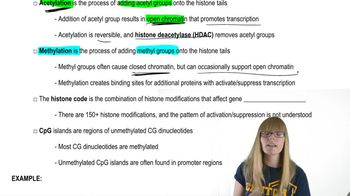How do we know how methylation of promoters silences gene expression?
Table of contents
- 1. Introduction to Genetics51m
- 2. Mendel's Laws of Inheritance3h 37m
- 3. Extensions to Mendelian Inheritance2h 41m
- 4. Genetic Mapping and Linkage2h 28m
- 5. Genetics of Bacteria and Viruses1h 21m
- 6. Chromosomal Variation1h 48m
- 7. DNA and Chromosome Structure56m
- 8. DNA Replication1h 10m
- 9. Mitosis and Meiosis1h 34m
- 10. Transcription1h 0m
- 11. Translation58m
- 12. Gene Regulation in Prokaryotes1h 19m
- 13. Gene Regulation in Eukaryotes44m
- 14. Genetic Control of Development44m
- 15. Genomes and Genomics1h 50m
- 16. Transposable Elements47m
- 17. Mutation, Repair, and Recombination1h 6m
- 18. Molecular Genetic Tools19m
- 19. Cancer Genetics29m
- 20. Quantitative Genetics1h 26m
- 21. Population Genetics50m
- 22. Evolutionary Genetics29m
13. Gene Regulation in Eukaryotes
Epigenetics, Chromatin Modifications, and Regulation
Problem 3
Textbook Question
What are the major mechanisms of epigenetic genome modification?
 Verified step by step guidance
Verified step by step guidance1
Understand that epigenetic genome modification refers to changes in gene expression or cellular phenotype without altering the underlying DNA sequence.
Learn about DNA methylation, which involves the addition of methyl groups to cytosine bases in CpG islands. This process typically represses gene expression by preventing transcription factors from binding to the DNA.
Explore histone modification, which includes acetylation, methylation, phosphorylation, and ubiquitination of histone proteins. These modifications alter the chromatin structure, making DNA more or less accessible for transcription.
Study non-coding RNA mechanisms, such as microRNAs (miRNAs) and long non-coding RNAs (lncRNAs), which regulate gene expression by interacting with mRNA or chromatin to influence transcription or translation.
Recognize the role of chromatin remodeling complexes, which physically reposition nucleosomes to either expose or hide specific DNA regions, thereby regulating gene accessibility and expression.
 Verified video answer for a similar problem:
Verified video answer for a similar problem:This video solution was recommended by our tutors as helpful for the problem above
Video duration:
1mPlay a video:
Was this helpful?
Key Concepts
Here are the essential concepts you must grasp in order to answer the question correctly.
Epigenetics
Epigenetics refers to the study of heritable changes in gene expression that do not involve alterations to the underlying DNA sequence. These changes can affect how genes are turned on or off and can be influenced by environmental factors, lifestyle, and developmental stages. Understanding epigenetics is crucial for grasping how organisms adapt and respond to their surroundings.
Recommended video:
Guided course

Chromatin
DNA Methylation
DNA methylation is a key epigenetic mechanism involving the addition of a methyl group to the DNA molecule, typically at cytosine bases. This modification can repress gene expression by preventing the binding of transcription factors and other proteins necessary for gene activation. It plays a significant role in processes such as development, genomic imprinting, and X-chromosome inactivation.
Recommended video:
Guided course

DNA Proofreading
Histone Modification
Histone modification involves the chemical alteration of histone proteins around which DNA is wrapped, influencing chromatin structure and gene accessibility. Common modifications include acetylation, methylation, and phosphorylation, which can either promote or inhibit gene expression. These modifications are dynamic and can be influenced by various factors, including environmental signals and cellular conditions.
Recommended video:
Guided course

Histone Protein Modifications
Related Videos
Related Practice
Textbook Question
376
views


